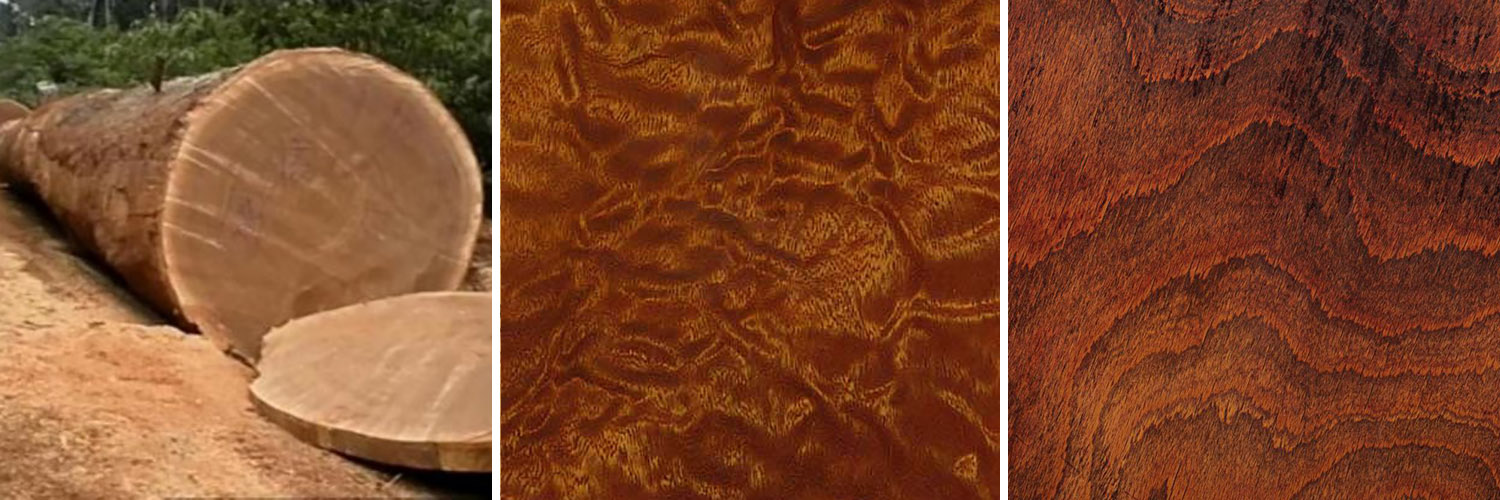Sapelli
Entandrophragma cylindricum, commonly known as the sapele or sapelli (/səˈpiːliː/ sə-pee-lee), is a large tree native to tropical Africa. The tree is also known as aboudikro. There are protected populations and felling restrictions in place in various countries.

Description:
Entandrophragma cylindricum grows to a height of up to 45 m (rarely 60 m). The leaves are deciduous in the dry season, alternately arranged, pinnate, with 5-9 pairs of leaflets, each leaflet about 10 cm long. The flowers are produced in loose inflorescences when the tree is leafless, each flower about 5 mm diameter, with five yellowish petals. The fruit is a pendulous capsule about 10 cm long and 4 cm broad; when mature it splits into five sections to release the 15-20 seeds.
Uses:
The commercially important wood is reminiscent of mahogany, a member of the same family, with a distinctive figure, typically applied where figure is important. It has a density of 640 kg per cubic metre.
Among its more exotic uses is that in musical instruments. It is used for the back and sides of acoustic guitar bodies, as well as the tops of electric guitar bodies. It is also used in manufacturing the neck piece of ukuleles and 26- and 36-string harps. In the late 90s, it started to be used as a board for Basque percussion instruments txalaparta.
Due to its strength and attractive reddish-brown colouring, sapele wood is increasingly used in staircase construction. With its close texture and interlocking grain, sapele is both harder and heavier than mahogany, making it a durable, cost-effective alternative.
This tall, straight African tree holds incredible value; ecologically, commercially, and even medicinally. The sapele is a member of the mahogany family, a group of trees which play an important structural role within tropical forests and have a high commercial value for their timber. The wide trunk bears no branches or leaves until around 30 metres, and has fairly dark, reddish or purplish brown heartwood, while the outer-wood is white to light rosy-red, covered with brownish-grey bark that is often peeling off in patches. The symmetrical crown of the sapele consists of pinnate, alternate leaves , and the numerous, small flowers consist of five petals and bloom in loose, open clusters. The fruits are elongated, woody capsules, and contain many brown, winged seeds. The sapele emits a distinct cedary odour. Also known as sapelli.
Sapele Biology:
The sapele is a long-lived and slow-growing tree that plays an important ecological role in the forests of west and central Africa. Sapele trees provide habitat for a number of rare monkeys in the Congo forests, such as Thollon’s red colobus (Procolobus badius tholloni) and mandrills (Mandrillus sphinx), and during the summer, the trees are also the unique host to a species of caterpillar Imbrasia (Nudaurelia) oyemensis. These caterpillars provide an important source of protein for forest-dwelling communities, and also an important source of income; collecting caterpillars can provide a higher annual income per hectare than growing crops.
How the large sapele tree reproduces is not entirely clear. It was considered to be hermaphroditic, with each flower containing both male and female organs, but more recent studies suggest that each sapele tree bears separate male and female flowers. Sapele trees begin to flower when they have a diameter of 20 centimetres, but only begin producing seeds when reaching a diameter of about 50 centimetres. Flowering occurs from November to February, and like other trees of the mahogany family, (Meliaceae), the sapele is pollinated by insects, primarily bees and moths. Each year, about one-third of mature sapele trees produce fruits, but flowering and fruiting are irregular among individuals and years, and seed production is erratic.
As well as housing protein-rich caterpillars, the sapele is also critical to local communities for their medicinal and structural properties. The bark of the sapele is believed to have anti-inflammatory properties and is used for the treatment of headaches, eye infections and swollen feet, and the trunk is used for dug-out canoes and the central roof support in homes.
